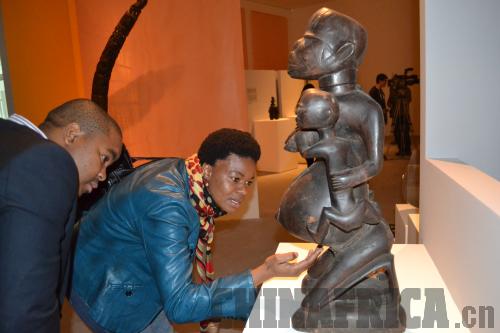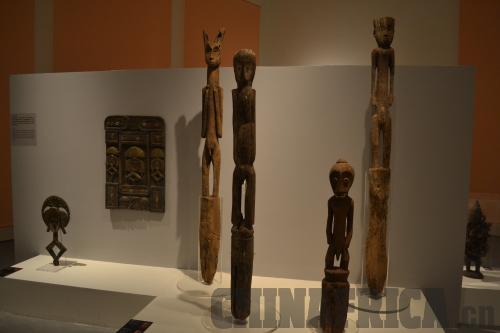| 
Botswanan students in China attended the exhibition
For Li Anqi, a 22-year-old senior student at East China Normal University, attending an exhibition of Sub-Saharan African art has changed her perception of the continent and its culture.
"In the past I thought there was just one African culture, but at the exhibition, I found out Africa has so many tribes and languages, and I'm amazed by its cultural diversity," she told ChinAfrica. "Learning their customs, daily life and religious beliefs helps me better understand African cultures," she added.
Entitled A Seed of Civilization - Exhibition of Sub-Saharan Art, the exhibition is held December 1, 2013-January 19 at Shanghai Himalayas Museum. It displays the objects ancient Africans from various tribes used for rituals and in daily life. Co-organized by the museum, the African Museum in Zhejiang Normal University (ZNU) and the university's Institute of African Studies, it brings Chinese people a good chance to understand the traditional art and culture of Sub-Saharan Africa without leaving Shanghai.
Displaying African art
At the exhibition visitors can see a wide range of masks used by various tribes on different occasions such as birth, harvest, marriage and death rituals.
"One characteristic of Sub-Saharan African art is that their art exists in their daily life," said Liu Hongwu, Director of ZNU's Institute of African Studies.
For example, the Dogon people, who mostly live in the central plateaus of Mali, have a special funeral ceremony known as "dama." Dogons dance wearing more than eight kinds of masks to communicate with the deceased. Their masks depict an array of animal images, including rabbits, lizards, antelopes, birds and monkeys.
Through the exhibit's re-creation of scenes of life and daily utensils, customs and cultures of different ethnic groups in the region are vividly depicted, offering viewers a chance to gain some insight into their lives.
In addition to African masks and the daily utensils used by different ethnic groups, photos of famous Western works are also on display.
"We hope to show visitors how African art exerted a profound influence on Western modern and contemporary art movements, including expressionism, cubism, fauvism and abstract art," said Xu Liang, the exhibition's project manager.
Africa remains, for many people, a place of exoticism and mystery, home to myriad forms of traditional culture, rituals and customs. "While we can see its influence in the canon of the 20th century art from the West, the tribal cultures that inspired Picasso and his contemporaries are often under-appreciated in their own right," commented Wang Chunjie, Director of Shanghai Himalayas Museum.

Exhibits on display at the exhibition
Experiencing African life
There is also an interactive area for visitors to participate in events that feature African music, dance, food, currency and art.
"Our educational events are mainly to help visitors better understand the close relations between African art and their daily life through participating in various cultural events," said Liu Lin, head of the museum's education and promotion department.
According to Liu, different classes such as African drumming, music and dance have been organized during the weekends. Participants can even learn some simple African language through reciting African children's songs at the class.
Li Anqi believes the museum is the best place to learn about cultures, especially exotic ones. "Apart from seeing the real artworks, we need to gain a comprehensive understanding of the culture through listening to music and watching videos," she said.
Bridging the communication gap
For Botswanan Kabalano Rampa, President of the Botswana Students' Association in China, hosting events like this exhibition will help bridge the communication gap. Having studied for an MBA at Nanchang University in Jiangxi Province for one year, he feels there are still some misunderstandings between Chinese and Africans. "It's not just about language, but more about cultural communications in terms of history and culture," he told ChinAfrica.
He believes that once the communication gap is bridged, it will be easier for ideas to flow and for people to work together. "We will appreciate each other more when we understand our cultural differences, while cultural similarities will help each other to relate," he said.
"China and Africa [ties] can only be made strong by deep and broad understanding of their cultural values and cultural differences," echoed Nigerian artist Njoku Saint Jerry A., who believes cultural understanding is critical for China-Africa relations.
"This exhibition shows how close we are. We are much closer to your culture than European or American culture," said Ambassador Antoine Ghonda, the representative of the President of the Democratic Republic of Congo. "In such a small environment, Chinese visitors can learn about our diverse cultures. It's very impressive," he said.
"Even though we are from different continents, we share many similarities, including our family and community values," said He Meng, Counselor at the Department of African Affairs of China's Ministry of Foreign Affairs.
Rampa hopes in the future, there will be more exhibitions of this kind with bigger scale and artworks from more of Africa's culturally diverse countries.
|